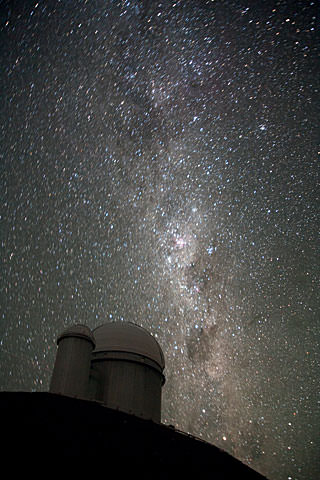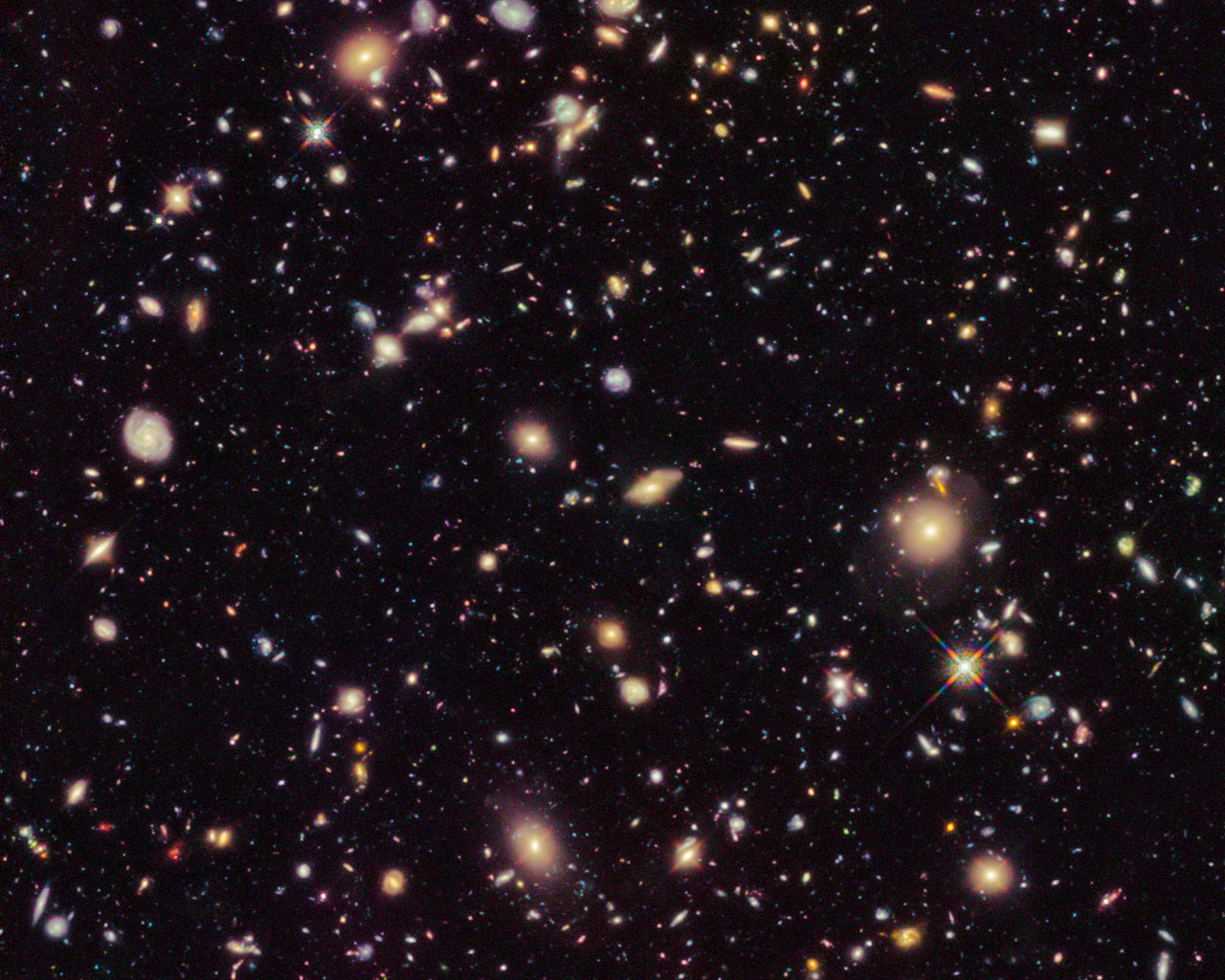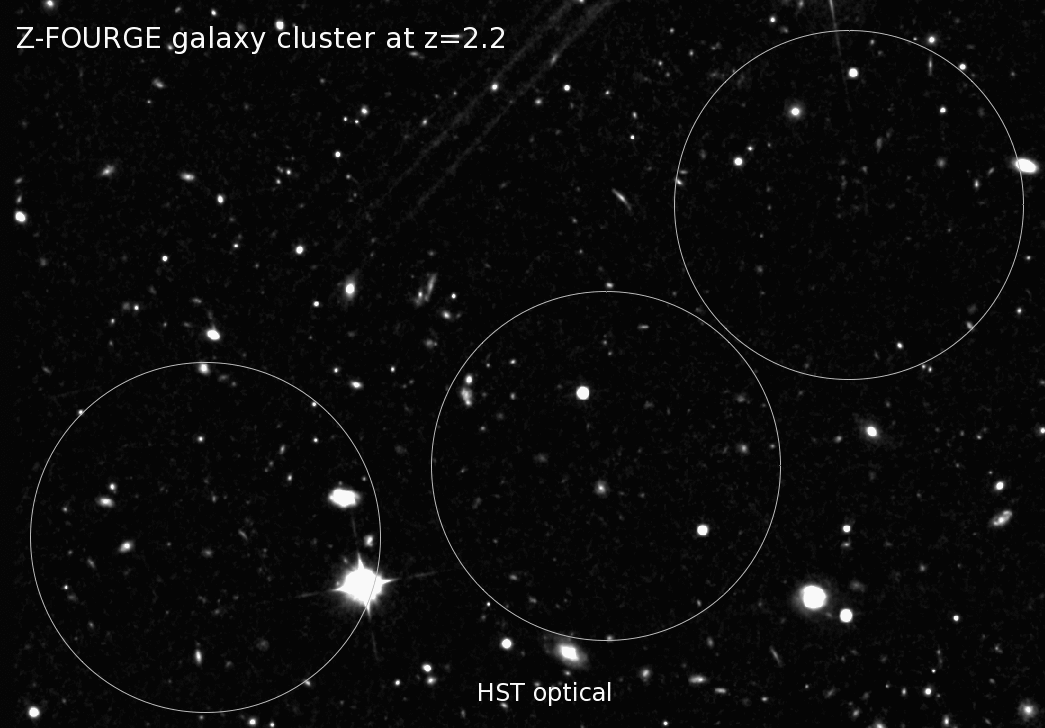[/caption]
Located some 10.5 billion light years away in the general direction of the constellation of Leo, the most distant cluster of red galaxies so far discovered has been hiding in plain sight… until now. Thanks to the advanced observing techniques of FourStar, a new and powerful near-infrared camera on the 6.5m Magellan Baade Telescope, we’re now able to peer beyond faint and into the realm of the faintest. It’s 30 galaxies packed like sardines in a tin and their formation is the earliest known “galaxy city” in the Universe!
“These are the first steps of accurately measuring the rate at which these large urban cities formed in a dark-matter-dominated universe,” says Texas A&M astronomer, Dr. Casey Papovich. “The rate at which they come together tests our understanding of how structures in the universe formed. The broader the timeline, the better our chances of being accurate. Instrumentation is key, and as it evolves, we’ll keep pushing the boundaries.”
Up until now, this galaxy conglomeration had remained undisclosed – despite thousand upon thousands of hours of survey images taken in their area. It is truly amazing that they were overlooked by the huge ground-based telescopes and space-based research instruments, including the Hubble Space Telescope. There was just no accurate distance estimations until the FourStar project came along. Headed by Eric Persson of the Carnegie Observatories, the stellar team includes Carnegie’s David Murphy, Andy Monson, Dan Kelson, Pat McCarthy, and Ryan Quadri – a group whose findings will be published in the Astrophysical Journal Letters.
Just what is FourStar? It’s a specialized camera set with a group of five very specific filters which are sensitively tuned to a very narrow portion of the near-infrared spectrum. “These new filters are a novel approach; it’s a bit like being able to do a CAT scan of the sky to rapidly make a 3-D picture of the early universe,” says Swinburne’s Karl Glazebrook, who is leading the Australian component of the international collaboration formed in 2009.What sets it apart is its ability to accurately measure distances between Earth and target galaxies one at a time. This allows the program to build an incredible three-dimensional look at the source point.
“Most other surveys were just looking at the tip of the iceberg,” Dr. Kim-Vy Tran explains. “The modern technology contained in this camera enabled us to detect the faintest light possible, allowing us to see much more of the iceberg than previously revealed. It’s like we’re using a comb to sift through the very distant universe. The combination of filters and depth provided by this camera give us the equivalent of more teeth, resulting in better measurements and more accurate results.”
The survey was built one deep over an 11×11 arcminute field each in COSMOS, CDFS and UDS. When it comes to galaxy properties, they are looking at 1-2% accurate redshifts and the current 3-D map is looking back to when the Universe was only 3 billion years old.
“This means the galaxy cluster is still young and should continue to grow into an extremely dense structure possibly containing thousands of galaxies,” explained lead author Lee Spitler of Australia’s Swinburne University of Technology.
The FourStar Galaxy Evolution Survey (“Z-FOURGE”) is just the beginning. Through studies of clusters like this one, astronomers can and will get a better understanding of how galaxy clusters evolve in relationship to their environments and – possibly – how they assemble into larger structures. The survey, led by Dr. Ivo Labbé, a former Carnegie postdoctoral fellow, now at Leiden Observatory in the Netherlands, will also strengthen our abilities to determine distances. In just a half a year, the team “has obtained accurate distances for faint galaxies over a region roughly one-fifth the apparent size of the Moon” locating about another thousand galaxies at even further extents.
“The excellent image quality and sensitivity of Magellan and FourStar really make the difference,” Labbé said. “We look forward to many more exciting and unexpected discoveries!”
Original Story Source: Carnegie Science News Release.



